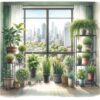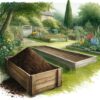Are your plants fighting for space?
As gardeners, we often focus on the essentials like sunlight, water, and nutrients when tending to our plants. However, one crucial aspect that sometimes gets overlooked is the need for adequate space. Understanding why plants require space is fundamental to cultivating a healthy and vibrant garden.
I know, I know… we all have limited space in the garden, and we try and pack as much joy into that small, limited space as we can. As a flower farmer, an avid gardener, I’ve been there and done that. One of our popular crops is dahlias, and I learned the hard way that if you don’t provide adequate space and airflow for these beauties, can you get mildew and mold, is the hot days of summer create a humidity layer close to the ground in the hot times. Read more on the importance of space below and see if yourself some hassle.
The Importance of Room to Grow
Root Growth and Nutrient Absorption
Plants, much like humans, need their personal space to thrive. The roots of a plant are its lifeline, absorbing water and nutrients from the soil. When plants are too close together, their roots can become entangled, leading to a battle for these essential resources. Ensuring each plant has enough room to spread its roots means a healthier growth and a more bountiful yield, whether it’s flowers, fruits, or foliage.
Sunlight and Air Circulation
Apart from the underground competition, space plays a vital role in above-ground health. Plants that are crammed together struggle to receive adequate sunlight, which is vital for photosynthesis. Poor air circulation in tightly packed plants also increases the risk of diseases and pest infestations. Adequate spacing allows each plant to receive the sunlight it needs and promotes better air circulation, reducing the likelihood of these issues.
Avoiding the Perils of Overcrowding
The Risk of Disease and Pests
Overcrowded plants create a haven for pests and diseases. Fungi and bacteria thrive in the moist, shaded environment that closely planted plants offer. Additionally, pests like aphids and mites can easily transfer from one plant to another when they are in close proximity. Spacing plants properly allows for better pest management and healthier plants.
Fungal, Mold, and Bacterial Issues
As mentioned, one of the less obvious yet critical aspects of garden health is air circulation. Poor air circulation in a garden can lead to a host of issues, particularly the development of fungal, mold, and bacterial problems. These issues not only affect the aesthetic appeal of your garden but can also have a detrimental impact on plant health.
Fungal Infestations
Fungi thrive in environments with stagnant air and high humidity. Poor air circulation creates a microclimate where moisture lingers on leaves and stems, making plants more susceptible to fungal diseases like powdery mildew, rust, and blight. These diseases manifest as discolored spots, powdery coatings, or wilted foliage, and can quickly spread, affecting the overall health of your garden.
Mold Growth
Mold growth, often seen as a fuzzy or slimy coating on soil and plant surfaces, is another consequence of inadequate air circulation. Mold spores are always present in the environment, but they proliferate in conditions where there is insufficient airflow and excessive moisture. Not only is mold unsightly, but it can also compete with plants for nutrients and can cause root rot, which is often fatal.
Bacterial Problems
Bacterial growth is another risk associated with poor air circulation. Bacteria can enter through wounds in the plant’s surface or natural openings and thrive in moist, airless conditions. They cause various issues, such as leaf spots, wilting, and stem rot, which can ultimately lead to the death of the plant.
Preventing Airflow-Related Issues
Pruning and Spacing
Regular pruning and ensuring proper spacing between plants are essential for improving air circulation. Removing dead or overcrowded branches allows air to flow more freely around and through plants, reducing moisture buildup.
Positioning & Spacing of Plants
Be mindful of plant placement, especially in container gardens or greenhouses. Ensure that plants are not placed too close to walls or each other, and use fans if necessary to improve air movement in enclosed spaces.
Monitoring Humidity
Keep an eye on humidity levels, particularly in greenhouse settings. Utilize dehumidifiers or increase ventilation to manage excessive humidity.
Choosing Resistant Varieties
Opting for disease-resistant plant varieties can also help in managing these problems. These plants are bred to be less susceptible to fungal, mold, and bacterial issues, thus requiring less intensive care in terms of airflow management.
In summary, good air circulation plays a pivotal role in preventing fungal, mold, and bacterial issues in your garden. By taking proactive steps to ensure adequate airflow, you can maintain a healthier, more resilient garden. Remember, a little extra attention to the way air moves around your plants can go a long way in preserving their beauty and vitality.
Spacing Guidelines
Read the Labels
Most plants come with recommended spacing guidelines. These recommendations are based on the mature size of the plant and its growth habits. Adhering to these guidelines ensures that each plant has enough room to grow to its full potential.
Consider Growth Patterns
Some plants, like vining varieties, need more space due to their sprawling nature, while others, like compact herbs, require less. Understanding the growth pattern of each plant will help you determine the right amount of space.
The Joy of a Well-Spaced Garden
A garden where plants have room to grow is not only healthier but also more aesthetically pleasing. Proper spacing allows each plant to showcase its beauty without being overshadowed by its neighbors. Additionally, a well-spaced garden is easier to maintain, as you can access plants without stepping on others, making your gardening experience more enjoyable.
In conclusion, giving your plants the space they need is as important as providing them with the right soil, water, and sunlight. It’s a simple yet crucial step in ensuring the health and beauty of your garden. So the next time you’re planting, remember: a little extra space can make all the difference. Happy gardening!










